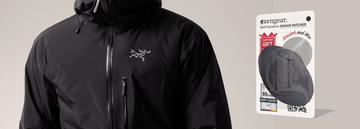Petit guide de sécurité en cas d'avalanche (deuxième partie)
par {{ author }} Emily Jannet au Jan 05, 2023
Nous avons déjà partagé un bref guide sur la sécurité en cas d'avalanche ici . Continuons ce sujet dans cet article de blog.
Savoir quoi faire en cas d'avalanche peut vous sauver la vie . C'est à ce moment-là que les mesures de sécurité les plus élémentaires (un sifflet puissant , une boussole , des vêtements de haute visibilité, etc.) peuvent et feront toute la différence.
Pour autant, il ne faut pas sous-estimer la puissance féroce et les capacités destructrices d'une avalanche pour se mettre en danger.
Que faire en cas d'avalanche
Les survivants d'une avalanche disent souvent que c'est la sensation la plus proche qu'ils puissent imaginer d'être coincés dans une machine à laver. Les chutes de glace et de neige peuvent atteindre rapidement des vitesses de plus de 130 km/h, ce qui signifie que même une avalanche mineure peut causer de graves dommages.
La première chose à faire est donc de chercher à se protéger du paysage environnant, s'il existe un abri ou une barrière stable. Les gros rochers et les entrées de grottes sont connus pour sauver des vies en cas d'avalanche, tout comme les grands arbres dans le cas d'avalanches plus petites.
Les experts conseillent également de retirer vos skis (si vous en portez) et de vous débarrasser de vos bâtons de ski/randonnée , ce qui pourrait entraîner d'autres blessures lorsque l'avalanche frappe.
Bien que cela soit plus facile à dire qu'à faire, les experts suggèrent également que la meilleure façon de survivre à une avalanche est de faire de son mieux pour « nager » jusqu'à la surface le plus rapidement possible. En quelques minutes, la neige et la glace d'une avalanche peuvent se comprimer jusqu'à atteindre la dureté du béton, ce qui rend pratiquement impossible toute sortie.
Si vous vous retrouvez coincé, essayez de dégager une poche d'air autour de votre nez et de votre bouche pour pouvoir respirer. Utilisez votre sifflet et tout autre équipement de sécurité dont vous disposez pour attirer l'attention et, si possible, sortez votre main (ou tout autre objet que vous pouvez) de la neige pour indiquer où vous vous trouvez.
Produit vedette :
Sifflet de sécurité puissant avec cordon en paracorde - Étanche, acier inoxydable
- DOUBLE TUBES : Sifflet d'urgence étanche super puissant nécessitant moins d'efforts pour souffler et générant un son clair à haute fréquence entendu à longue distance
- PORTE-CLÉS ET LANIÈRE EN PARACORDE INCLUS : Chaque sifflet est livré avec une lanière en paracorde de qualité supérieure ainsi qu'un anneau porte-clés - vous pouvez le porter autour de votre cou, dans votre poche ou l'attacher à votre sac à dos
- DURABLE ET PORTABLE : Conception primée, fabriquée en acier inoxydable, elle pèse moins de 40 g et est légère, très petite et facile à transporter
- RÉSISTANT AUX INTEMPÉRIES : Excellente conception de flux d'air - peut être utilisé dans tous les environnements météorologiques pour le camping, la navigation de plaisance, la randonnée, la chasse, la pêche, les activités d'entraînement en plein air, la promenade de chiens, les entraîneurs, les arbitres, les sauveteurs, l'autodéfense, le bushcraft, la survie, le sauvetage, les sports, les signaux de détresse, la dissuasion des coyotes
Aider une personne ensevelie dans une avalanche
Les recherches suggèrent que les victimes d'avalanche retrouvées dans les 15 minutes ont 90 % de chances de survivre. Malheureusement, ce chiffre tombe à seulement 20 % pour celles qui sont coincées pendant 45 minutes ou plus.
Si vous parvenez à localiser et à récupérer une victime d'avalanche dans la neige, enveloppez-la dans une couverture en aluminium et faites de votre mieux pour la garder au chaud. Donnez-lui à manger et à boire jusqu'à l'arrivée des secours et continuez à lui parler si elle a du mal à rester consciente.
N'essayez pas de les déplacer si vous pensez qu'ils ont des blessures graves et consultez les services d'urgence pour obtenir des conseils (si vous avez un téléphone portable en état de marche).
Réduire le risque de blessures par avalanche
Bien entendu, l’approche la plus efficace en matière de sécurité contre les avalanches est de faire tout ce que vous pouvez pour éviter de vous retrouver dans une situation d’urgence.
Quelle que soit votre destination, il est important de surveiller de près les prévisions météorologiques avant de partir. Dans la plupart des destinations européennes, un bulletin d'avalanches spécialisé est également disponible, avec une échelle de gravité de 1 à 5.
Les avalanches les plus dangereuses se produisent assez rapidement, il faut donc garder un œil sur les conditions météorologiques à tout moment. Cela est particulièrement vrai si vous partez sur plusieurs jours, car les chutes de neige pendant la nuit peuvent à elles seules entraîner des conditions dangereuses.
Demandez conseil aux locaux et consultez un guide expert avant de vous aventurer hors des pistes. Ne prenez jamais les choses pour acquises, surtout si vous manquez de connaissances et d'expérience locales.
Il est également possible de suivre un cours professionnel de sécurité en avalanche, au cours duquel vous apprendrez à détecter à l'avance les signes potentiels d'une avalanche. Vous serez également familiarisé avec toutes les techniques essentielles de premiers secours post-avalanche, ce qui vous permettra de mieux venir en aide aux personnes prises dans une situation d'urgence.






